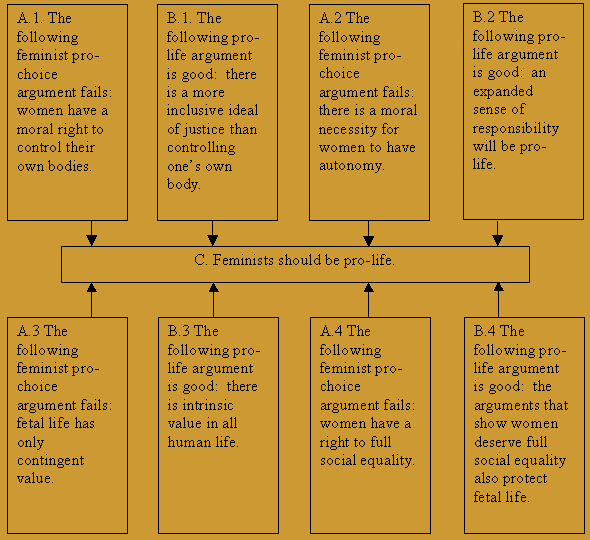
 |
||||
PHI332 : The Class : Essays : Practice
You are ready to start diagramming the main structure of whole essays. Let us begin with Sidney Callahan's "A Case for Pro-Life Feminism," pp. 366-368 in your text. I chose Callahan because she1 makes her arguments easier to identify than any other author in the "abortion" section.
I expect that many of you will find it frustrating to try to figure out the outline of the argument in whole essays. You are justified: it is frustrating! It involves guessing at an author's meaning, which very often is not clear.
If you are becoming annoyed with the whole plan of this course, perhaps you expected ethics to be something less nitpicky. Perhaps you have assumed it was easy to figure out the truth in these matters? I'm not sure that I can justify such an assumption. It would mean that everyone who disagrees with you must be intolerably stupid or wicked-and that doesn't seem likely.
More likely, you assumed ethics was something easy because after all (one might
think), ethics is really just a matter of listening to and nodding politely
at other's opinions in a classroom or meeting and then smiling tolerantly. I'm
not sure I can justify this assumption, either-whatever shall we do in health
care crises that call for life and death decisions, and no one agrees, but some
choice must be made? Nodding politely won't get us far then.
On the other hand, if you have supposed that ethics is an honest-to-God search for truth, so far as human beings are capable of knowing it, it won't surprise you that it requires careful thinking about people's reasons.
Title
Notice Callahan's title on p. 366: "A Case for Pro-Life Feminism."
The title tells us to expect an argument (a "case" is an argument)
for Pro-Life Feminism. This title, like any good title, tells us the thesis
(the bottom line; the main conclusion) for which the essay is arguing. We can
already begin our diagram of the whole essay based upon the title alone:
We don't yet know the premises, although we are told what the conclusion is. But wait!-Conclusions must be declarative statements, and our conclusion in the diagram is a sentence fragment. This is a serious error-we must convert this sentence fragment into a complete sentence. Type in a couple of guesses below, changing the sentence fragment to a declarative statement, then go on to the next page.
Here are some possible ways to restate the conclusion as a declarative statement:
Standard form
Now I try to fit Callahan's essay into standard form by skimming it:
INTRODUCTION first three paragraphs, pp. 366-367.
BODY
CONCLUSION I didn't find one as I skimmed it.
Remember from 3.3 that we expect the argument of such an essay to have the following general structure:

Based on my skimming of the section titles, I can expect the general form of the essay's argument to be as follows:

I might have to revise this diagram as I get into the details, but it gives me a sense of how the author will argue. Based on my skimming, I can also give the following section-level diagram of the essay.

Next I'll try to sketch the arguments of each section. I am not trying to diagram the arguments inside of each paragraph, as I did in Module 2 of this course. I am mainly interested in the topic sentences of each paragraph in a section. Some might be background information; some might be premises supporting the conclusion of the section. Let's begin with section "1" (really 5) on pp. 368-370.
I expect this section to argue that there is "a more inclusive ideal of justice" than "the moral right to control one's own body," which will lead to a pro-life conclusion. (Why do I expect this? --Look at the section title, and remember the main thesis of this essay.)
To complete this topic successfully, do as many of the following exercises as you find necessary to acquire the relevant skill. You have acquired the relevant skill when your answers to exercises are reliably either the same as the given answers or are alternative answers you can explain and defend:
|
|
|
|
Go on to Module
4: Argument Evaluation
or
Go back to Argument
ID in Essays
E-mail George Rudebusch at George.Rudebusch@nau.edu
or call (520) 523-7091
|
Copyright © 2001 Northern
Arizona University
ALL RIGHTS RESERVED |